Page 12 of 452
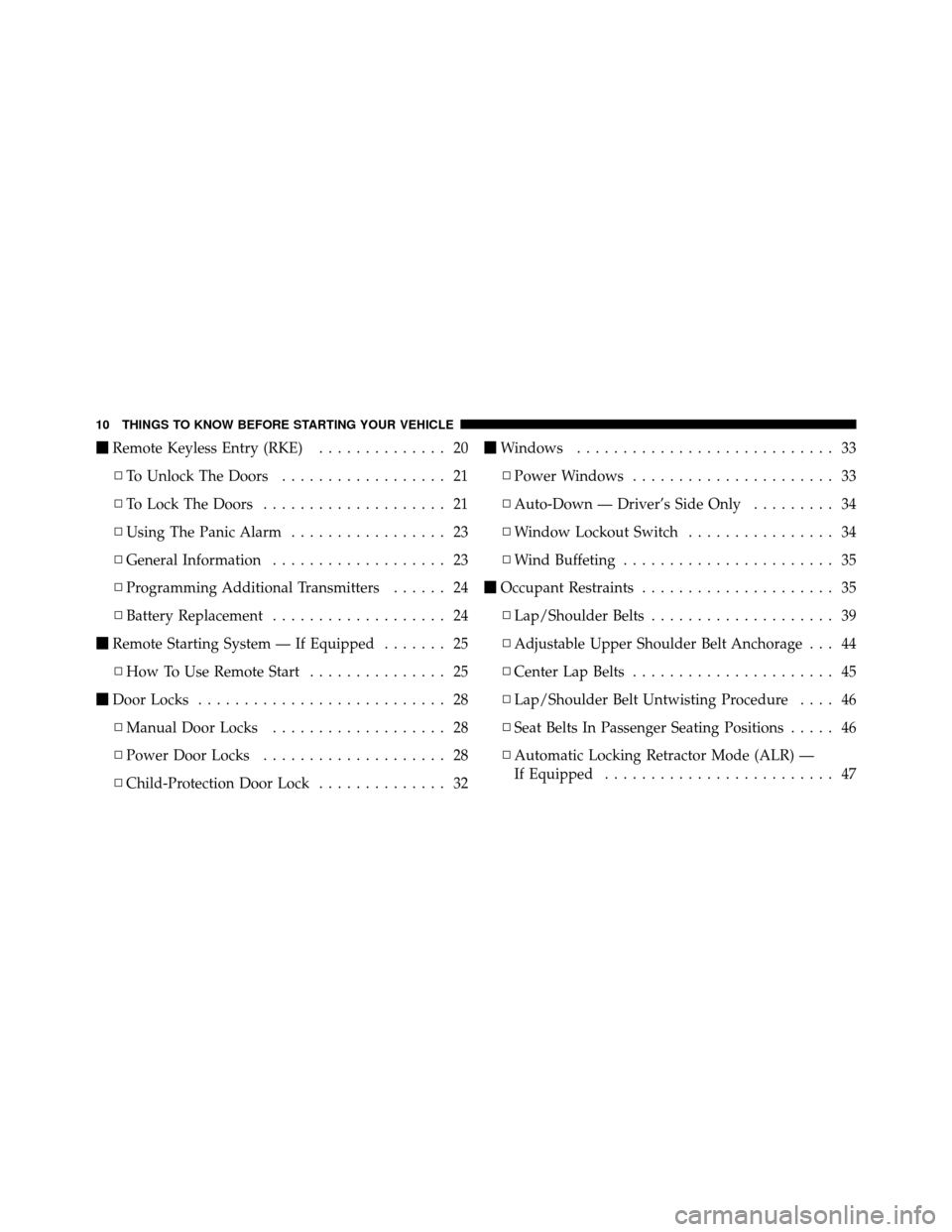
�Remote Keyless Entry (RKE) .............. 20
▫ To Unlock The Doors .................. 21
▫ To Lock The Doors .................... 21
▫ Using The Panic Alarm ................. 23
▫ General Information ................... 23
▫ Programming Additional Transmitters ...... 24
▫ Battery Replacement ................... 24
� Remote Starting System — If Equipped ....... 25
▫ How To Use Remote Start ............... 25
� Door Locks ........................... 28
▫ Manual Door Locks ................... 28
▫ Power Door Locks .................... 28
▫ Child-Protection Door Lock .............. 32�
Windows ............................ 33
▫ Power Windows ...................... 33
▫ Auto-Down — Driver’s Side Only ......... 34
▫ Window Lockout Switch ................ 34
▫ Wind Buffeting ....................... 35
� Occupant Restraints ..................... 35
▫ Lap/Shoulder Belts .................... 39
▫ Adjustable Upper Shoulder Belt Anchorage . . . 44
▫ Center Lap Belts ...................... 45
▫ Lap/Shoulder Belt Untwisting Procedure .... 46
▫ Seat Belts In Passenger Seating Positions ..... 46
▫ Automatic Locking Retractor Mode (ALR) —
If Equipped ......................... 47
10 THINGS TO KNOW BEFORE STARTING YOUR VEHICLE
Page 13 of 452
▫Seat Belt Pretensioners ................. 48
▫ Energy Management Feature ............. 48
▫ Enhanced Seat Belt Use Reminder System
(BeltAlert�) ......................... 49
▫ Seat Belts And Pregnant Women .......... 50
▫ Seat Belt Extender ..................... 51
▫ Supplemental Restraint System (SRS) – Air
Bags .............................. 51
▫ Advanced Front Air Bag Features .......... 53
▫ Air Bag Deployment Sensors And Controls . . . 55 ▫
Event Data Recorder (EDR) .............. 62
▫ Child Restraints ...................... 63
� Engine Break-In Recommendations .......... 75
� Safety Tips ........................... 76
▫ Transporting Passengers ................ 76
▫ Exhaust Gas ......................... 77
▫ Safety Checks You Should Make Inside The
Vehicle ............................. 78
▫ Periodic Safety Checks You Should Make
Outside The Vehicle ................... 80
2
THINGS TO KNOW BEFORE STARTING YOUR VEHICLE 11
Page 33 of 452
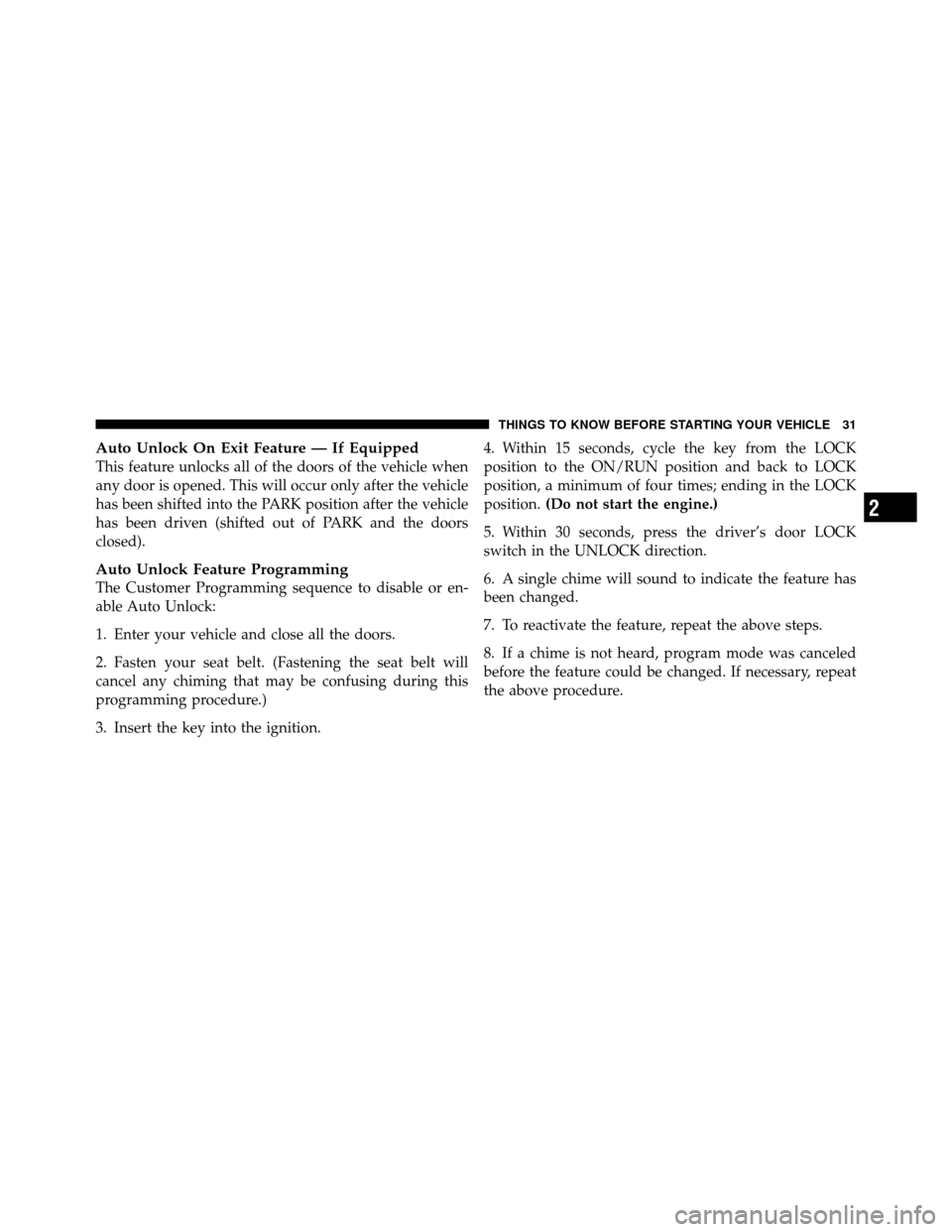
Auto Unlock On Exit Feature — If Equipped
This feature unlocks all of the doors of the vehicle when
any door is opened. This will occur only after the vehicle
has been shifted into the PARK position after the vehicle
has been driven (shifted out of PARK and the doors
closed).
Auto Unlock Feature Programming
The Customer Programming sequence to disable or en-
able Auto Unlock:
1. Enter your vehicle and close all the doors.
2. Fasten your seat belt. (Fastening the seat belt will
cancel any chiming that may be confusing during this
programming procedure.)
3. Insert the key into the ignition.4. Within 15 seconds, cycle the key from the LOCK
position to the ON/RUN position and back to LOCK
position, a minimum of four times; ending in the LOCK
position.
(Do not start the engine.)
5. Within 30 seconds, press the driver’s door LOCK
switch in the UNLOCK direction.
6. A single chime will sound to indicate the feature has
been changed.
7. To reactivate the feature, repeat the above steps.
8. If a chime is not heard, program mode was canceled
before the feature could be changed. If necessary, repeat
the above procedure.
2
THINGS TO KNOW BEFORE STARTING YOUR VEHICLE 31
Page 37 of 452
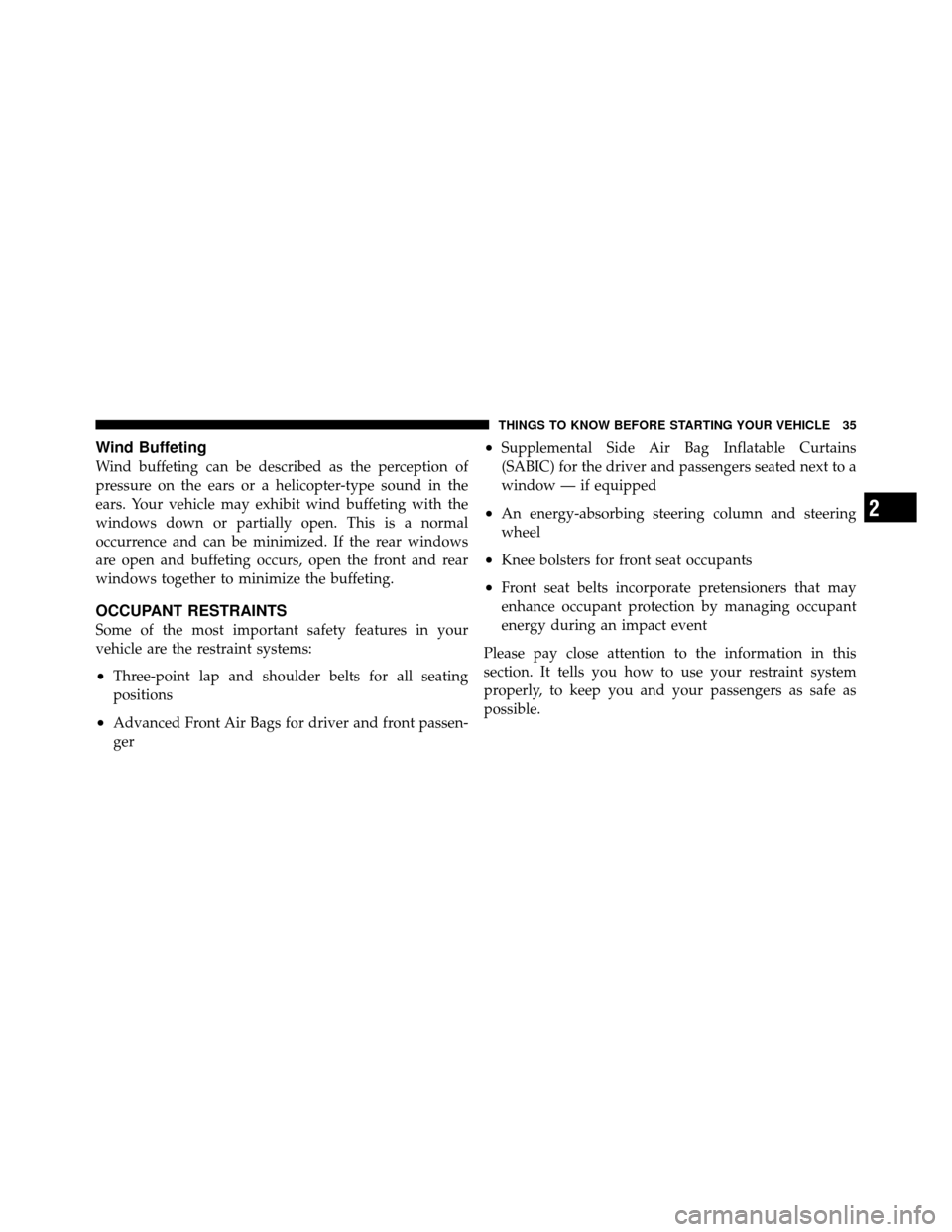
Wind Buffeting
Wind buffeting can be described as the perception of
pressure on the ears or a helicopter-type sound in the
ears. Your vehicle may exhibit wind buffeting with the
windows down or partially open. This is a normal
occurrence and can be minimized. If the rear windows
are open and buffeting occurs, open the front and rear
windows together to minimize the buffeting.
OCCUPANT RESTRAINTS
Some of the most important safety features in your
vehicle are the restraint systems:
•Three-point lap and shoulder belts for all seating
positions
•Advanced Front Air Bags for driver and front passen-
ger
•Supplemental Side Air Bag Inflatable Curtains
(SABIC) for the driver and passengers seated next to a
window — if equipped
•An energy-absorbing steering column and steering
wheel
•Knee bolsters for front seat occupants
•Front seat belts incorporate pretensioners that may
enhance occupant protection by managing occupant
energy during an impact event
Please pay close attention to the information in this
section. It tells you how to use your restraint system
properly, to keep you and your passengers as safe as
possible.
2
THINGS TO KNOW BEFORE STARTING YOUR VEHICLE 35
Page 38 of 452
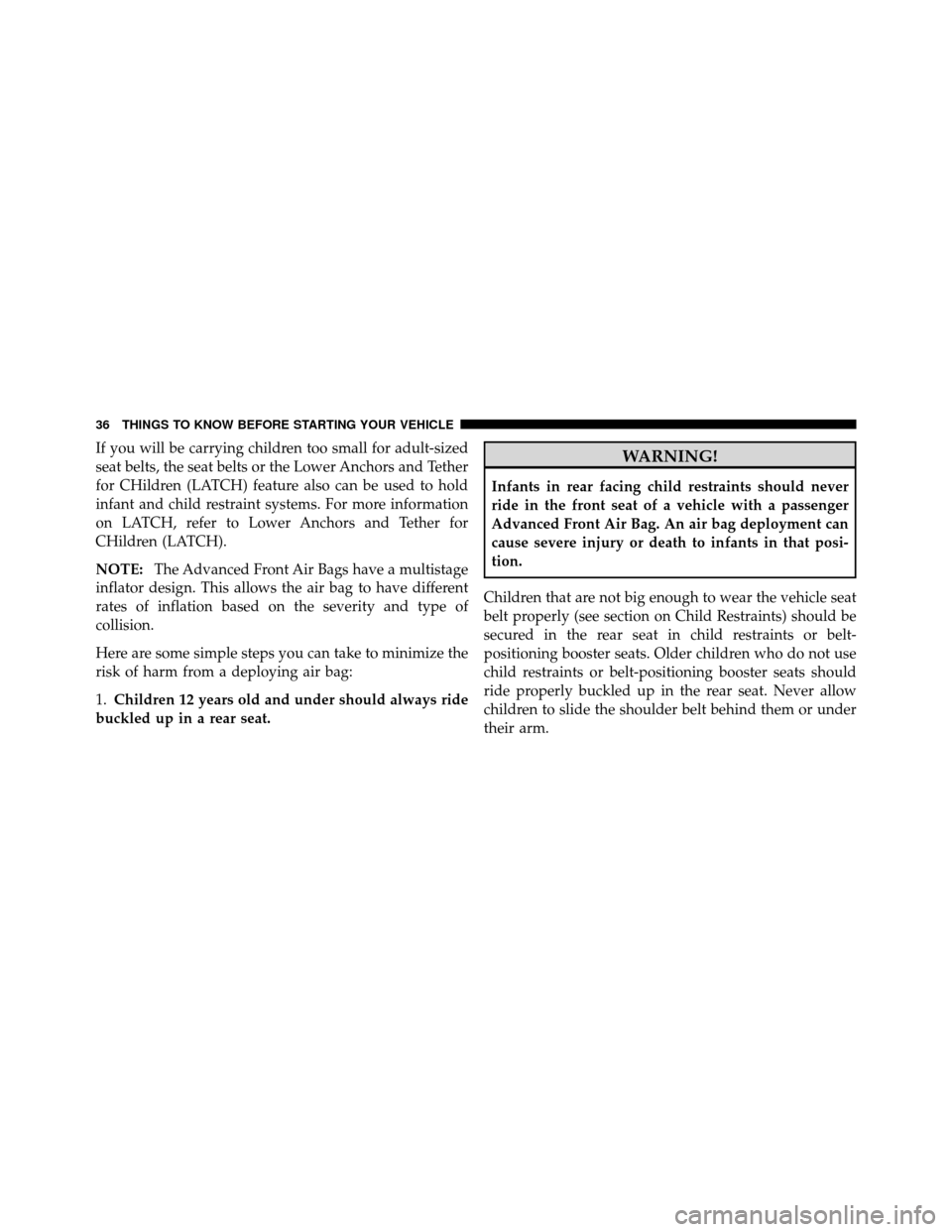
If you will be carrying children too small for adult-sized
seat belts, the seat belts or the Lower Anchors and Tether
for CHildren (LATCH) feature also can be used to hold
infant and child restraint systems. For more information
on LATCH, refer to Lower Anchors and Tether for
CHildren (LATCH).
NOTE:The Advanced Front Air Bags have a multistage
inflator design. This allows the air bag to have different
rates of inflation based on the severity and type of
collision.
Here are some simple steps you can take to minimize the
risk of harm from a deploying air bag:
1. Children 12 years old and under should always ride
buckled up in a rear seat.WARNING!
Infants in rear facing child restraints should never
ride in the front seat of a vehicle with a passenger
Advanced Front Air Bag. An air bag deployment can
cause severe injury or death to infants in that posi-
tion.
Children that are not big enough to wear the vehicle seat
belt properly (see section on Child Restraints) should be
secured in the rear seat in child restraints or belt-
positioning booster seats. Older children who do not use
child restraints or belt-positioning booster seats should
ride properly buckled up in the rear seat. Never allow
children to slide the shoulder belt behind them or under
their arm.
36 THINGS TO KNOW BEFORE STARTING YOUR VEHICLE
Page 39 of 452
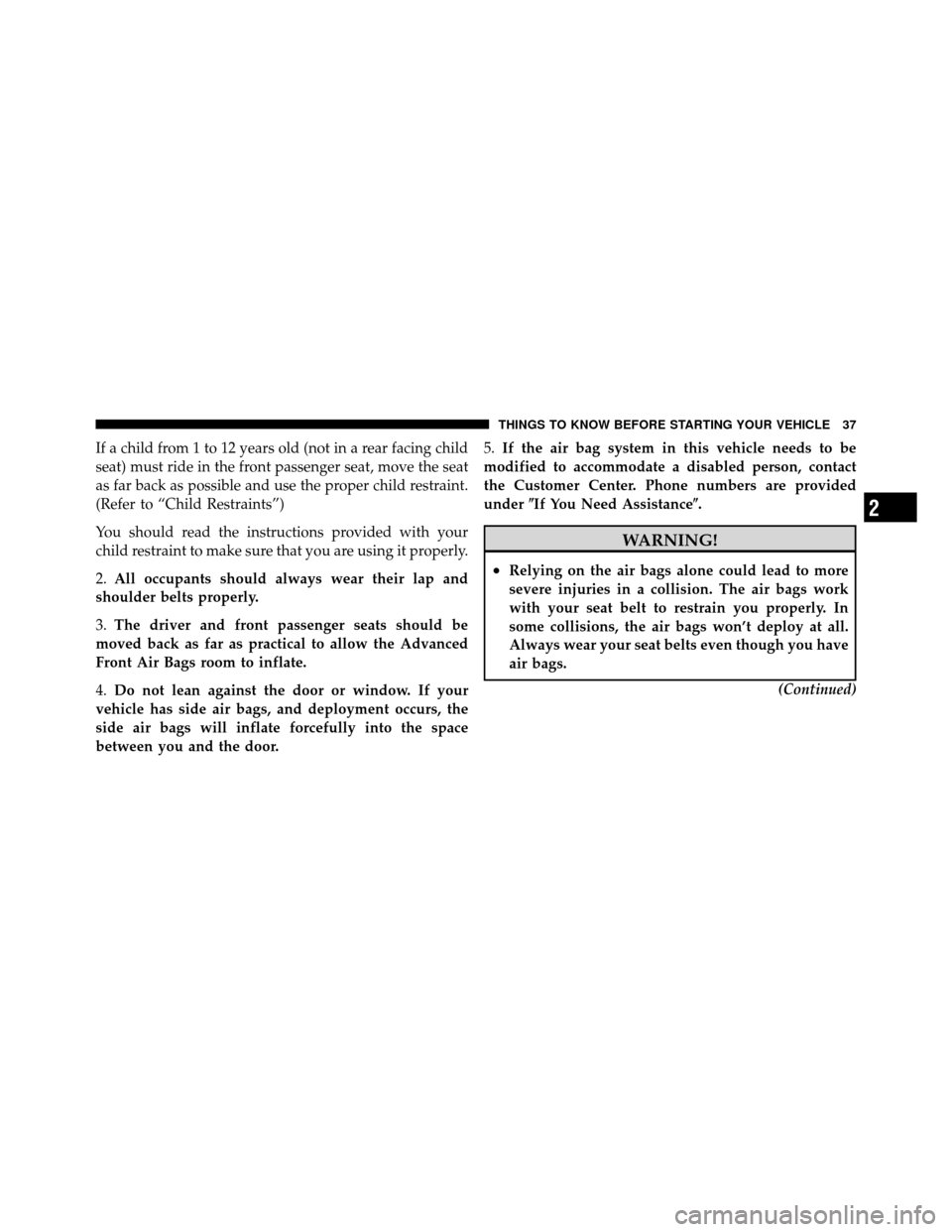
If a child from 1 to 12 years old (not in a rear facing child
seat) must ride in the front passenger seat, move the seat
as far back as possible and use the proper child restraint.
(Refer to “Child Restraints”)
You should read the instructions provided with your
child restraint to make sure that you are using it properly.
2.All occupants should always wear their lap and
shoulder belts properly.
3. The driver and front passenger seats should be
moved back as far as practical to allow the Advanced
Front Air Bags room to inflate.
4. Do not lean against the door or window. If your
vehicle has side air bags, and deployment occurs, the
side air bags will inflate forcefully into the space
between you and the door. 5.
If the air bag system in this vehicle needs to be
modified to accommodate a disabled person, contact
the Customer Center. Phone numbers are provided
under �If You Need Assistance�.
WARNING!
•Relying on the air bags alone could lead to more
severe injuries in a collision. The air bags work
with your seat belt to restrain you properly. In
some collisions, the air bags won’t deploy at all.
Always wear your seat belts even though you have
air bags.
(Continued)
2
THINGS TO KNOW BEFORE STARTING YOUR VEHICLE 37
Page 40 of 452
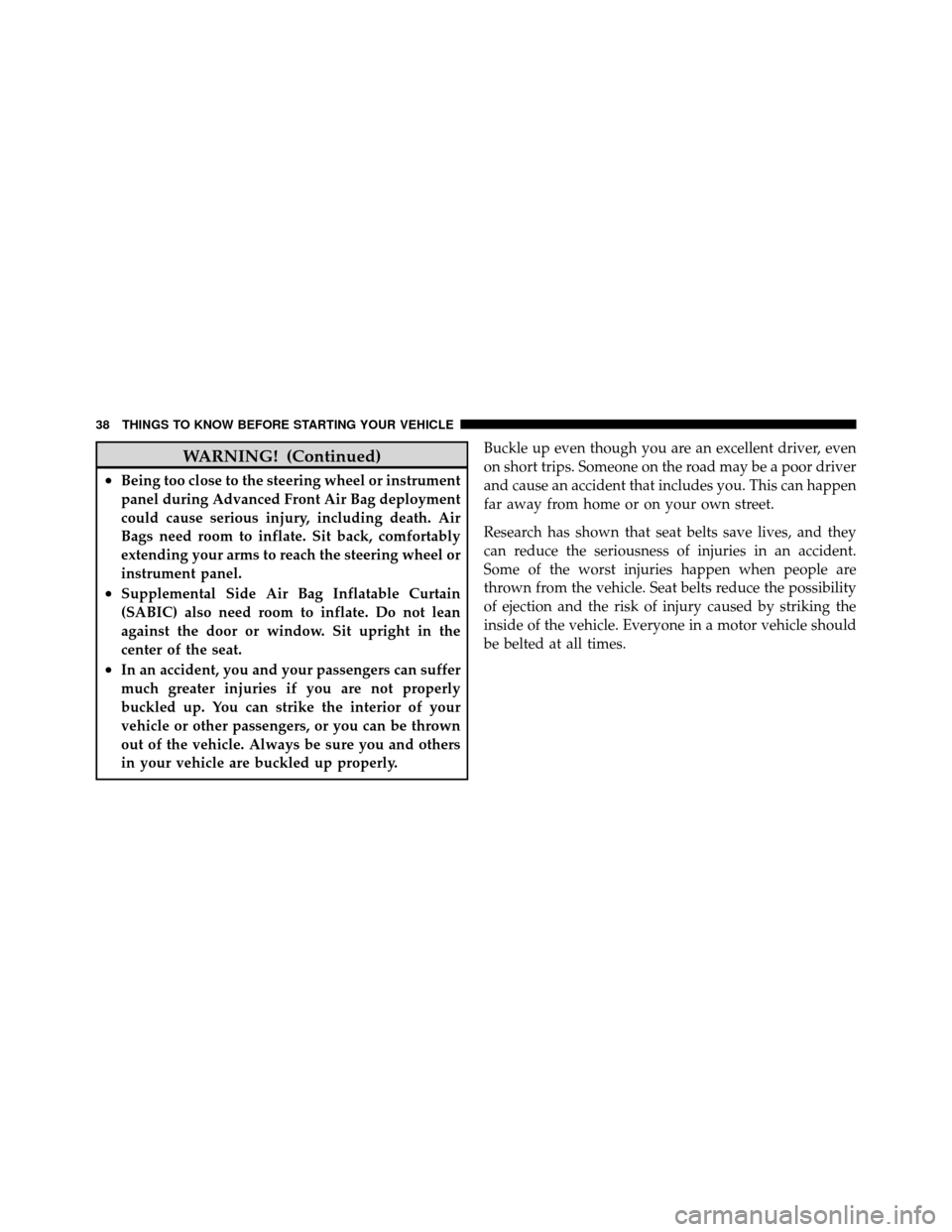
WARNING! (Continued)
•Being too close to the steering wheel or instrument
panel during Advanced Front Air Bag deployment
could cause serious injury, including death. Air
Bags need room to inflate. Sit back, comfortably
extending your arms to reach the steering wheel or
instrument panel.
•Supplemental Side Air Bag Inflatable Curtain
(SABIC) also need room to inflate. Do not lean
against the door or window. Sit upright in the
center of the seat.
•In an accident, you and your passengers can suffer
much greater injuries if you are not properly
buckled up. You can strike the interior of your
vehicle or other passengers, or you can be thrown
out of the vehicle. Always be sure you and others
in your vehicle are buckled up properly.Buckle up even though you are an excellent driver, even
on short trips. Someone on the road may be a poor driver
and cause an accident that includes you. This can happen
far away from home or on your own street.
Research has shown that seat belts save lives, and they
can reduce the seriousness of injuries in an accident.
Some of the worst injuries happen when people are
thrown from the vehicle. Seat belts reduce the possibility
of ejection and the risk of injury caused by striking the
inside of the vehicle. Everyone in a motor vehicle should
be belted at all times.
38 THINGS TO KNOW BEFORE STARTING YOUR VEHICLE
Page 41 of 452
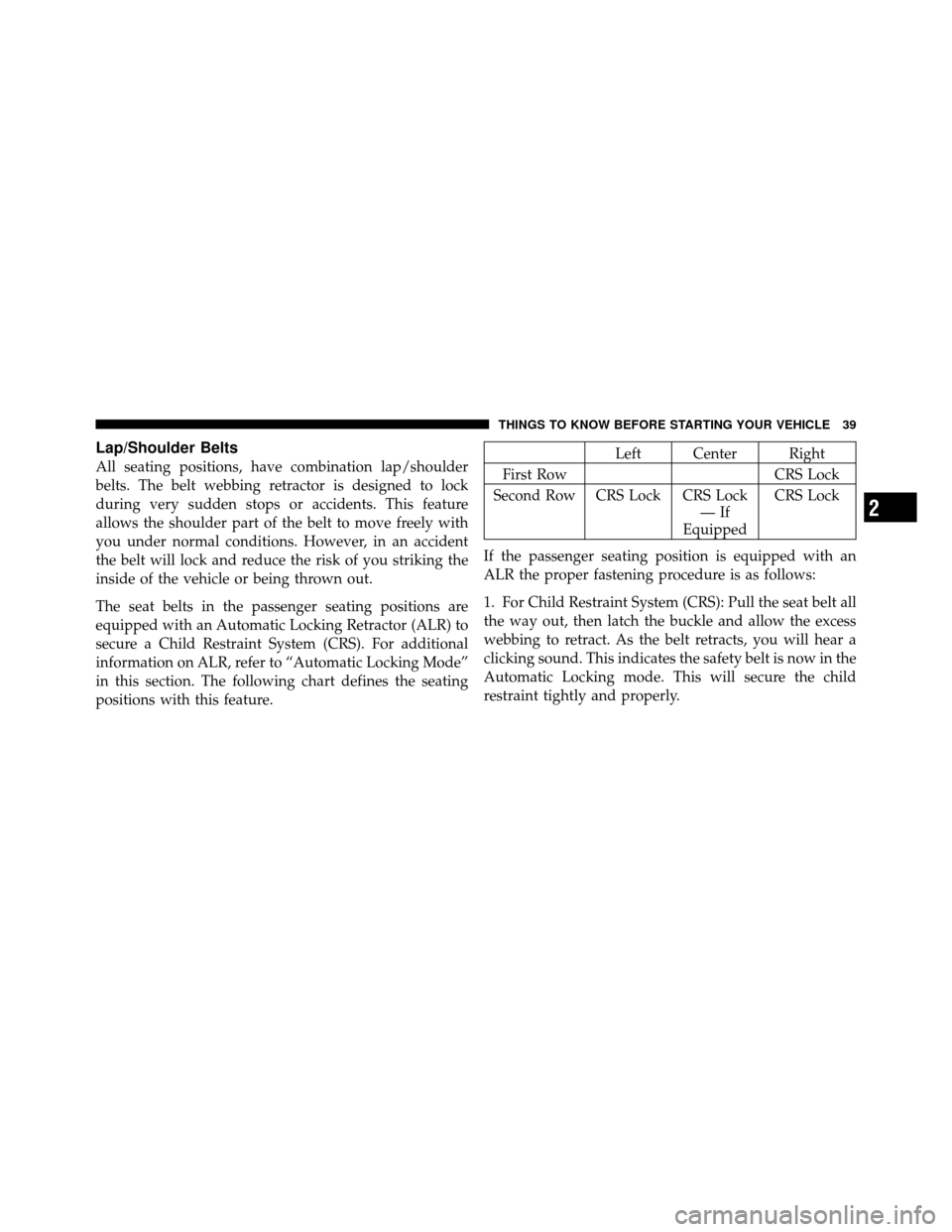
Lap/Shoulder Belts
All seating positions, have combination lap/shoulder
belts. The belt webbing retractor is designed to lock
during very sudden stops or accidents. This feature
allows the shoulder part of the belt to move freely with
you under normal conditions. However, in an accident
the belt will lock and reduce the risk of you striking the
inside of the vehicle or being thrown out.
The seat belts in the passenger seating positions are
equipped with an Automatic Locking Retractor (ALR) to
secure a Child Restraint System (CRS). For additional
information on ALR, refer to “Automatic Locking Mode”
in this section. The following chart defines the seating
positions with this feature.Left Center Right
First Row CRS Lock
Second Row CRS Lock CRS Lock —If
Equipped CRS Lock
If the passenger seating position is equipped with an
ALR the proper fastening procedure is as follows:
1. For Child Restraint System (CRS): Pull the seat belt all
the way out, then latch the buckle and allow the excess
webbing to retract. As the belt retracts, you will hear a
clicking sound. This indicates the safety belt is now in the
Automatic Locking mode. This will secure the child
restraint tightly and properly.
2
THINGS TO KNOW BEFORE STARTING YOUR VEHICLE 39